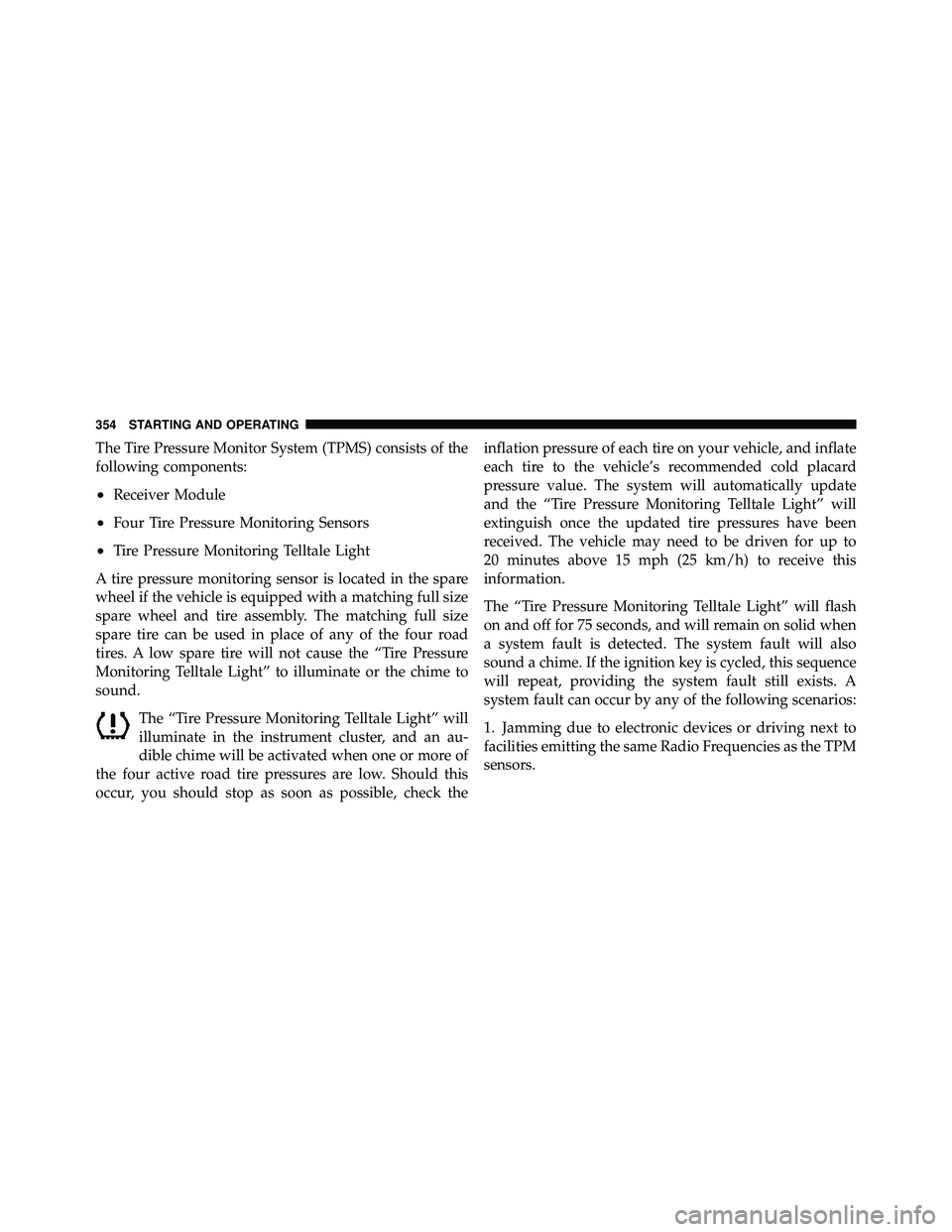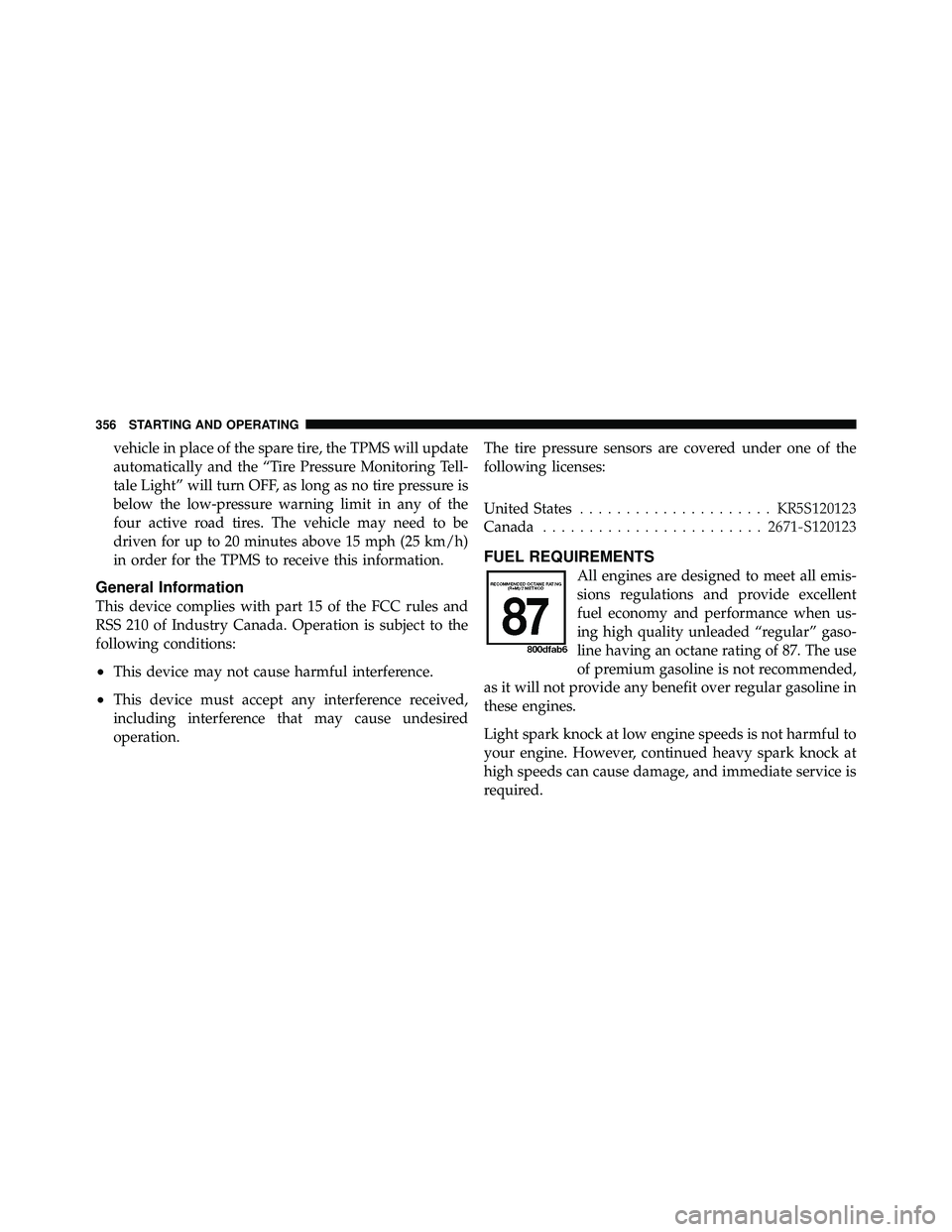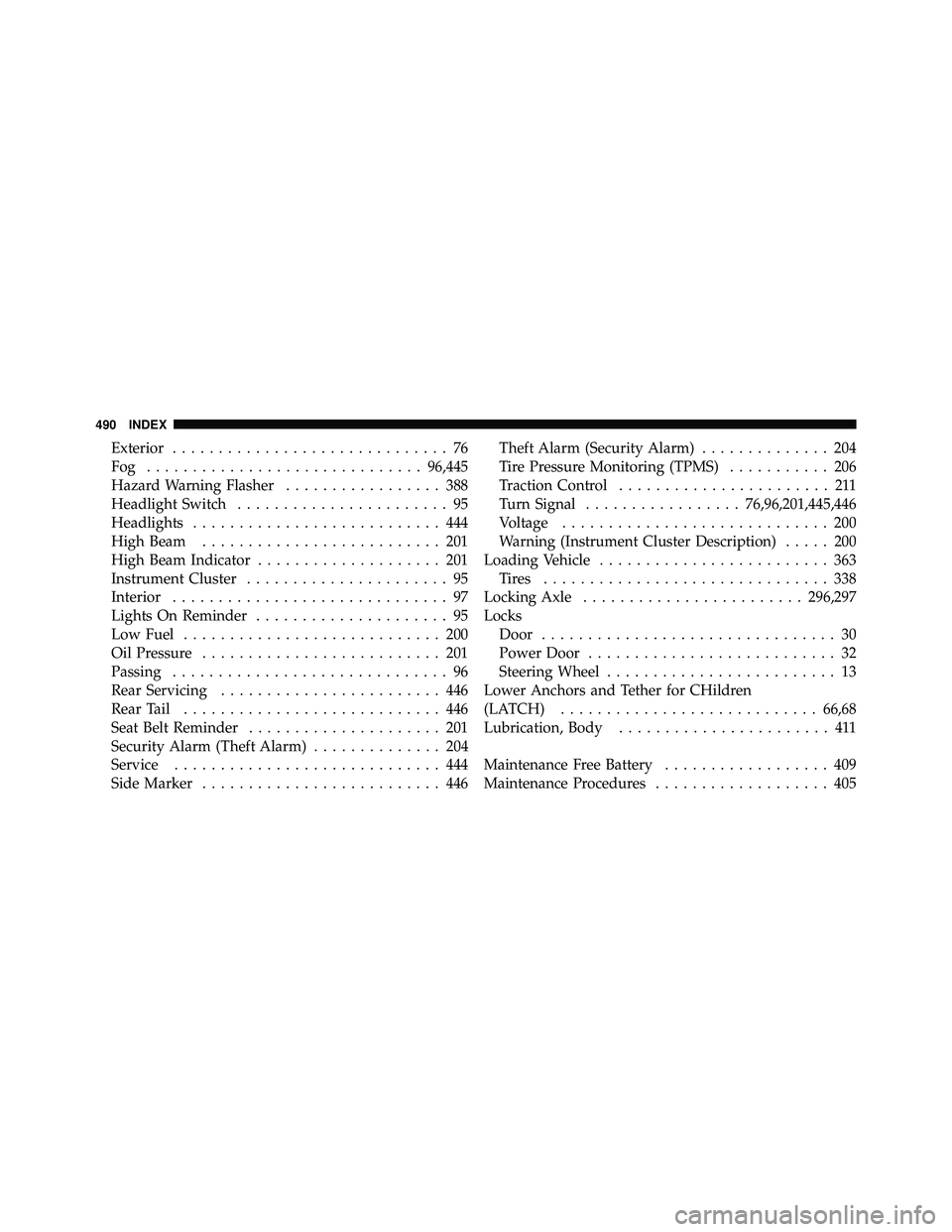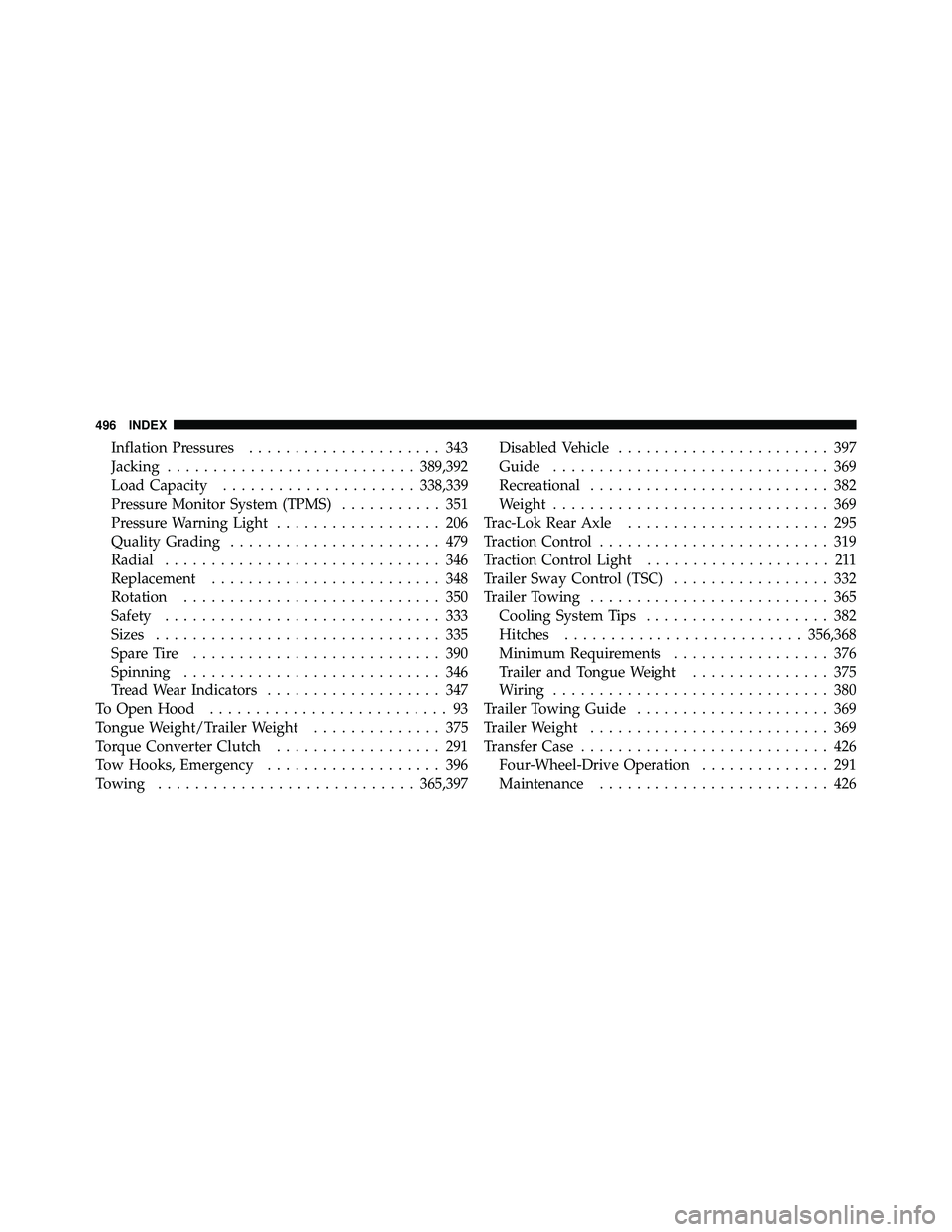TPMS JEEP WRANGLER 2009 Owners Manual
[x] Cancel search | Manufacturer: JEEP, Model Year: 2009, Model line: WRANGLER, Model: JEEP WRANGLER 2009Pages: 502, PDF Size: 13.82 MB
Page 208 of 502

21. Odometer / Trip Odometer Reset Button
Press this button to change the display from odometer to
either of the two trip odometer settings. Trip A or Trip B
will appear when in the trip odometer mode. Press and
hold the button for two seconds to reset the trip odometer
to 0 miles or kilometers. The odometer must be in trip
mode to reset.
22. Shift Lever Indicator
The Shift Lever Indicator is self-contained within the
instrument cluster. It displays the gear position of the
automatic transmission.
23. Tire Pressure Monitoring Telltale LightEach tire, including the spare (if provided),
should be checked monthly, when cold and
inflated to the inflation pressure recommended
by the vehicle manufacturer on the vehicle placard or tire
inflation pressure label. (If your vehicle has tires of a
different size than the size indicated on the vehicle placard or tire inflation pressure label, you should deter-
mine the proper tire inflation pressure for those tires.)
As an added safety feature, your vehicle has been
equipped with a Tire Pressure Monitoring System
(TPMS) that illuminates a low tire pressure telltale when
one or more of your tires is significantly under-inflated.
Accordingly, when the low tire pressure telltale illumi-
nates, you should stop and check your tires as soon as
possible, and inflate them to the proper pressure. Driving
on a significantly under-inflated tire causes the tire to
overheat and can lead to tire failure. Under-inflation also
reduces fuel efficiency and tire tread life, and may affect
the vehicle’s handling and stopping ability.
Please note that the TPMS is not a substitute for proper
tire maintenance, and it is the driver ’s responsibility to
maintain correct tire pressure, even if under-inflation has
not reached the level to trigger illumination of the TPMS
low tire pressure telltale.
Page 356 of 502

The Tire Pressure Monitor System (TPMS) consists of the
following components:
•Receiver Module
•Four Tire Pressure Monitoring Sensors
•Tire Pressure Monitoring Telltale Light
A tire pressure monitoring sensor is located in the spare
wheel if the vehicle is equipped with a matching full size
spare wheel and tire assembly. The matching full size
spare tire can be used in place of any of the four road
tires. A low spare tire will not cause the “Tire Pressure
Monitoring Telltale Light” to illuminate or the chime to
sound. The “Tire Pressure Monitoring Telltale Light” will
illuminate in the instrument cluster, and an au-
dible chime will be activated when one or more of
the four active road tire pressures are low. Should this
occur, you should stop as soon as possible, check the inflation pressure of each tire on your vehicle, and inflate
each tire to the vehicle’s recommended cold placard
pressure value. The system will automatically update
and the “Tire Pressure Monitoring Telltale Light” will
extinguish once the updated tire pressures have been
received. The vehicle may need to be driven for up to
20 minutes above 15 mph (25 km/h) to receive this
information.
The “Tire Pressure Monitoring Telltale Light” will flash
on and off for 75 seconds, and will remain on solid when
a system fault is detected. The system fault will also
sound a chime. If the ignition key is cycled, this sequence
will repeat, providing the system fault still exists. A
system fault can occur by any of the following scenarios:
1. Jamming due to electronic devices or driving next to
facilities emitting the same Radio Frequencies as the TPM
sensors.
Page 358 of 502

vehicle in place of the spare tire, the TPMS will update
automatically and the “Tire Pressure Monitoring Tell-
tale Light” will turn OFF, as long as no tire pressure is
below the low-pressure warning limit in any of the
four active road tires. The vehicle may need to be
driven for up to 20 minutes above 15 mph (25 km/h)
in order for the TPMS to receive this information.
General Information
This device complies with part 15 of the FCC rules and
RSS 210 of Industry Canada. Operation is subject to the
following conditions:
•This device may not cause harmful interference.
•This device must accept any interference received,
including interference that may cause undesired
operation.The tire pressure sensors are covered under one of the
following licenses:
United States
..................... KR5S120123
Canada ........................ 2671-S120123
FUEL REQUIREMENTS
All engines are designed to meet all emis-
sions regulations and provide excellent
fuel economy and performance when us-
ing high quality unleaded “regular” gaso-
line having an octane rating of 87. The use
of premium gasoline is not recommended,
as it will not provide any benefit over regular gasoline in
these engines.
Light spark knock at low engine speeds is not harmful to
your engine. However, continued heavy spark knock at
high speeds can cause damage, and immediate service is
required.
Page 492 of 502

Exterior.............................. 76
Fog .............................. 96,445
Hazard Warning Flasher ................. 388
Headlight Switch ....................... 95
Headlights ........................... 444
High Beam .......................... 201
High Beam Indicator .................... 201
Instrument Cluster ...................... 95
Interior .............................. 97
Lights On Reminder ..................... 95
Low Fuel ............................ 200
Oil Pressure .......................... 201
Passing .............................. 96
Rear Servicing ........................ 446
Rear Tail ............................ 446
Seat Belt Reminder ..................... 201
Security Alarm (Theft Alarm) .............. 204
Service ............................. 444
Side Marker .......................... 446 Theft Alarm (Security Alarm)
.............. 204
Tire Pressure Monitoring (TPMS) ........... 206
Traction Control ....................... 211
Turn Signal ................. 76,96,201,445,446
Voltage ............................. 200
Warning (Instrument Cluster Description) ..... 200
Loading Vehicle ......................... 363
Tires ............................... 338
Locking Axle ........................ 296,297
Locks Door ................................ 30
Power Door ........................... 32
Steering Wheel ......................... 13
Lower Anchors and Tether for CHildren
(LATCH) ............................ 66,68
Lubrication, Body ....................... 411
Maintenance Free Battery .................. 409
Maintenance Procedures ................... 405
490 INDEX
Page 498 of 502

Inflation Pressures..................... 343
Jacking ........................... 389,392
Load Capacity ..................... 338,339
Pressure Monitor System (TPMS) ........... 351
Pressure Warning Light .................. 206
Quality Grading ....................... 479
Radial .............................. 346
Replacement ......................... 348
Rotation ............................ 350
Safety .............................. 333
Sizes ............................... 335
Spare Tire ........................... 390
Spinning ............................ 346
Tread Wear Indicators ................... 347
To Open Hood .......................... 93
Tongue Weight/Trailer Weight .............. 375
Torque Converter Clutch .................. 291
Tow Hooks, Emergency ................... 396
Towing ............................ 365,397Disabled Vehicle
....................... 397
Guide .............................. 369
Recreational .......................... 382
Weight .............................. 369
Trac-Lok Rear Axle ...................... 295
Traction Control ......................... 319
Traction Control Light .................... 211
Trailer Sway Control (TSC) ................. 332
Trailer Towing .......................... 365
Cooling System Tips .................... 382
Hitches .......................... 356,368
Minimum Requirements ................. 376
Trailer and Tongue Weight ............... 375
Wiring .............................. 380
Trailer Towing Guide ..................... 369
Trailer Weight .......................... 369
Transfer Case ........................... 426
Four-Wheel-Drive Operation .............. 291
Maintenance ......................... 426
496 INDEX